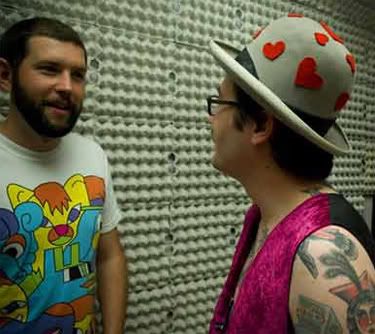
Ben talks to a friend at the "Psychedelic Club", part of a project being undertaken at the residency program at the Center for Contemporary Art in Warsaw.
Ben Peterson is an artist currently residing in Philadelphia, artblog talked to him in detail back in May regarding his all-round awesomeness and detail-oriented mega-realistic yet fantastical landscapes/architectures. Once I overheard a friend who isn't all that into art in general compliment one of Ben's pieces by saying "If I was high I could look at that all day". . . so drug-induced stupor or no Ben's the kind of artist who generously serves up a cornucopia of mysterious detail to the viewer.
Mr. Peterson recently had the opportunity to visit Poland for an artist residency, so I thought I'd talk to him about the nature of artist residencies and Polish art. I found a wealth of information that I'm only just beginning to process and thought I'd let everyone in on my new knowledge adventure:
Residency in a Castle
Annette: What was the residency called?
Ben: I don't know if it had a name. The center is called Ujazdowski Castle.
A: It was in a castle?
B: Castle is a loose term. I think it's more like an old hunting lodge you might visit for the weekend. . . it was pretty much rarely used from the way I understand it and then it was just bombed to shit during World War II.
A: So it was an old-stone building?
B: No. Don't think romantic, think governmental building. Think civic building and think plaster. It's really not what you'd expect from a castle, it has some towers but they are only towers in the since that there are four of them on each edge. No moat or princesses.
A: You're kind of ruining this for me.
B: I know. It was used as a hospital during WW I, then leveled during WW II and during the 1970s there was a cultural revival that went on in Poland and it was rebuilt. I don't know know what it was used for at first but I believe during the 1980's it became what is now The Center for Contemporary Art and I think not long after the artist residency program was established.
When the phone rings say yes
A: So how did you happen to end up at this non-castle?
B: The artists are nominated by a couple of different groups in America. . . I only know some of them because I guess it's a blind nomination. I know one of them is The Headlands Center for the Arts. . .
A: And that's another residency program?
B: Yes. That's the one I did in California. So basically a bunch of people are nominated and then they just decide form those nominations who they are interested in having come out.
A: So you don't apply for this? You just basically get a phone call one day like "Hey! You wanna go to Poland?"
B: Yep.

This is the Polish flag.
The day I arrived the director went on vacation.
A: So what exactly do you do in a Polish artist residency?
B: The day I landed the residency director was going on vacation.
A: What?
B: Yeah. So I think partly to give me a real, interesting experience of Poland and partly so I wouldn't be wondering around Warsaw without any help, she took me to this small sculpture center in the middle of nowhere. I stayed there for a week and that was really surreal.
A: Surreal how?
B: It was a left-over communist-party sculpture center where older artists would go to work on gigantic marble and granite sculptures.
A: Like sculptures of workers with big muscles?
B: Not so much. They definitely had a socialist-realist bent but it was more like heavy 1920's, 1930's Modernism. Think vaguely futurist, but the center has fallen into misuse so the only people who go there are. . . I don't know how to describe them. . . I guess you could say they are just holding on to an older period in Poland's art history. There are some people working on contemporary stuff there, but it's mostly a refuge for the old-guard.
Of roommates and monster-drawings that lock you in
A: So you were the only person in the residency?
B: At first. There wasn't a clear-cut program so I just kind of wondered around looking at stuff for a week. Eventually the rest of the people in the residency showed up and I went back to Warsaw, but there was really no schedule. I ended up doing what I do here (wake up, get coffee, work on art) except for the fact that my roommate was involved in this project that entailed reenacting the 60s, which kind-of didn't really happen in Poland, as far as what we think of as 60s culture. I usually coin his project "the hippie project".
A: So did you accomplish what you wanted to at the residency? Before you left you were talking of this plan to create what sounded like a monster of a drawing. . . and I know your work takes time to make.
B: Yeah. The drawing was a good and a bad idea. In the end I didn't complete it there because it was such a massive undertaking. It would have been impossible for me to finish it and still experience the residency. If I had wanted to finish that piece I should have stayed at home, locked in my studio.
A: So your process is completely autonomous from your environment? Poland didn't influence what you were doing in any way?
B: The drawing took many elements from the environment but I would have had to explain them to you for you to see them. I never make work where I immediately try to relate to an environment, it's just too heavy-handed. I would never try to depict another culture that I'm completely unfamiliar with as if I am really capable of understanding it.

"The Hippie Project"
Tell me again what you told me when you were drunk
A: You mentioned something at the bar the other night about trying on firemen's outfits and dancing in fields. . . what was that all about?
B: The one thing that I participated in for "the hippie project" was going to these art festivals that were held in smaller towns. I don't have anyway to really say that these festivals are a very European thing because this was the first time I ever visited Europe, but I believe they are. I think it's new for Poland, though, because many of the towns seemed to be a little freaked out.
One we went to took the form of a tour. Our first stop was an ice-cream parlor where all the ice-cream was hand-made and came straight from the cow to you. The next stop we went to was to the local post-man's house and he showed us his stamp collection, which was massive and amazing. Then we went to an excessively old theater that probably once lead life as a church, where three musicians played us what I would loosely term "psychedelic rock." We went on to visit the firemen and they told us about their jobs and let us try on their outfits. The tour ended at the house of a woman who worked for a very important contemporary art organization in Poland and she showed us her extensive collection.
Ask not what you can do for Poland but what Poland can do for you
A: What did Poland get out of the residency?
B: That's a good question and it seemed like that was the one on the average polish person's mind and the answer is I don't know. The whole idea of offering something tangible seems off to me. I don't think you can start out by thinking you can give something to anywhere that it needs.
A: It seems like you got something out of it.
B: There is the possibility that other people did too. I certainly brought my experiences and opinions to any discussion I was apart of. I hope I didn't leave a bad taste for Americans. I don't think I did.
During our talk Ben mentioned many Polish artists and resources, here are some links to just a few:
Piktogram. A quarterly, bilingual, international art magazine based in Warsaw, Poland.
Oskar Hansen. A very influential Polish architect, artist, and teacher. One of his most important ideas was that of Open Form. Here we can see some of his work at The Hoover Dam
Andre Cadere, left behind an oeuvre consisting of about 180 Barres de Bois of different lengths.
Krzystof Wodicko, "by appropriating public buildings and monuments as backdrops for projections, Wodiczko focuses attention on ways in which architecture and monuments reflect collective memory and history". . .
Miroslaw Balka. "Balka explores how subjective traumas are translated into collective histories and vice versa.". . .
Center for Contemporary Art in Warsaw
This was originally posted on artblog
No comments:
Post a Comment